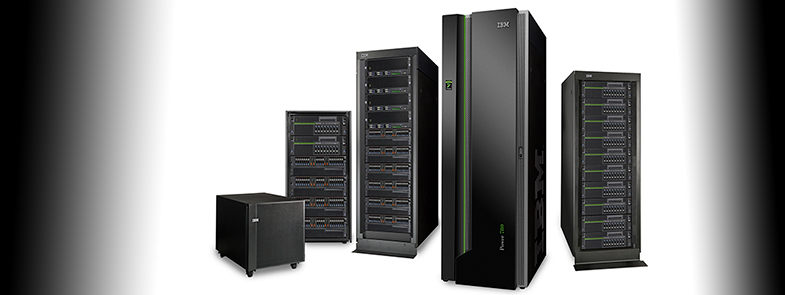IBM announced Technology Refreshes 7 and 1 for IBM i 7.3 and 7.4, respectively.
On October 8, 2019, IBM announced Technology Refreshes 7 and 1 for IBM i 7.3 and 7.4, respectively. Please see 7.4 TR 1 announcement letter and the 7.3 TR 7 announcement letter.
7.4 Technology Refresh 1
Below are the details from the 7.4 announcement letter:
- The Integrated Web Server (IWS) environment can now be deployed in a user-specified subsystem, giving users better control and management of system resources. The IWS has also improved the programmatic deployment functionality.
- The Digital Certificate Manager (DCM) has added a new GUI that simplifies and improves certificate management on IBM i.
- IBM i System Transport Layer Security (TLS) is enhanced to comply with emerging industry standards for TLSv1.3 and improve support for TLSv1.2.
- Cluster administrative domain has increased the monitored resource entries (MREs) limit. This allows room for cluster growth and increases usability of key functions, such as support to replicate an encrypted password. It also enables changes to the synchronization option on inactive nodes and adds a new format to the Retrieve Monitored Resource Information (QfpadRtvMonitoredResourceInfo) API to provide sorting, subsetting, and a continuation option.
- IBM Db2 for i includes new and improved SQL capabilities with attributes that are valued by business computing solutions.
- IBM Db2 Mirror for i has new capabilities, such as the initial version of the application evaluation support tool and support for Live Partition Mobility and the S922.
- IBM PowerHA SystemMirror for i brings several enhancements to the PowerHA portfolio, including:
- Improvements to the administrative domain, such as support for replicating user-profile passwords that have been set with the QSYSUPWD API
- Increased capacity of the administrative domain with support for synchronizing up to 200,000 monitored resources
- Faster and easier management of the administrative domain so users can easily sort and filter monitored resources with the WRKCADMRE command
- Simplified setup and implementation of the administrative domain with a streamlined way to easily find and add many resources using a single command
- Integrated and streamlined recovery from a data center outage in a HyperSwap® with a LUN-level switching environment that enables HyperSwap protection to be restored with a single command
- IBM Backup, Recovery, and Media Services for i (BRMS) provides virtual tape image catalog and backup administration improvements.
- The RPG language of IBM Rational Development Studio for i (RDS) includes overloading for procedure calls. RPG now has a framework to generate many other data languages, such as XML, JSON, YAML, and HTML from RPG data structures, that help enhance programmer productivity.
- IBM Rational Developer for i (RDi) includes refactoring functionality and improved indexing and searching within the preferences support.
- IBM i Access Client Solutions (ACS) schema support provides better search and find capabilities. Additionally, "Run SQL Scripts" has been enhanced with many updates, including content assist, integrated save-as favorites, timestamps showing query execution times, and more.
- With new open source enhancements, popular technologies for messaging between application components, storing data, and so on are easily available in RPM form.
- A new generation of enterprise 2.5-inch solid-state drives (SSD) improves enterprise-class reliability, endurance, and capacity characteristics.
- IBM i 7.4 TR1 supports PCIe3 x8 SSD NVMe adapters that provide multiple capacity points for enterprise workloads on selected Power servers with POWER9 technology. Support is for selected dedicated and VIOS VSCSI attached NVMe devices. This low-latency alternative to dedicated SAS storage fulfills the Statement of Direction from the April 24, 2019, IBM i 7.4 announcement.
- IBM i supports the new processor feature for 11-core or 22-core configurations of the IBM Power System S924 server, which provides additional choices for the scale-out market.
- SR-IOV logical ports can be assigned to IBM i LPARs that are configured with restricted I/O. This allows high-speed, low-latency network adapter usage while still being able to use Live Partition Mobility. This new support also enables the use of RoCE for IBM i on the IBM Power System S922 server.
Note: RoCE is required for the IBM Db2 Mirror for i product.
- License keys can be added to an IBM i LPAR through the HMC or Novalink interface. This saves time for administrators because they no longer need to sign in to each individual LPAR when additional keys are required. Managers of multitenancy environments with multiple servers will find this especially helpful, as will those migrating to a new server.
One of the coolest features regarding 7.4 TR 1 is the new user interface for Digital Certificate Manager. I had the good fortune to have a sneak peek at this back in May and got to beta test it for the last couple of months. The new GUI really makes things simple from a certificate-management perspective. The key to a good user interface is the ability for a user to intuitively interact without the need for a manual or even a question. It’s super slick and easy to navigate, and it takes a lot of the foolishness out, like needlessly having to provide different credentials for each certificate store. This one’s 7.4 only and one of those things you’ll want to get up to 7.4 to take advantage of.
Run SQL Scripts has been enhanced as part of IBM Access Client Solutions. Of course, you can use the ACS client with all supported versions of IBM i, so these new features are operating system release–independent. New features will be available sometime in November or December as part of version 1.8.0.3. Features are led by the very cool SQL Content Assist, which provides help in building your SQL statements. For the expert SQL developer, it may be a moot point, but for the majority of customers, this is a welcome addition. Think of it as F4 to prompt for commands inside PDM. OK, this is a poor example as it’s way better than that. Insert from Examples will have a bunch of new examples to play with. The 5250 interface will be augmented to take advantage of the F8 key that allows you to roll forward through your previous commands. If you haven’t seen this support then be sure to check it out. A new application package has been added to support the ODBC driver running native as part of the PASE environment. This allows ODBC access to the Db2 database from open-source languages like PHP, Python, and Node.js running on IBM i.
The ability to add license keys via the HMC is really killer from a systems-management perspective. It’s just nice to see. For smaller shops, it’s really a non-issue, but if you’ve got 40 partitions to apply keys into, this is a serious time saver.
7.4 TR1 also has enhanced IBM i System Transport Layer Security (TLS) to comply with emerging industry standards for TLSv1.3 and improve support for TLSv1.2:
- TLSv1.3 has been enhanced to support elliptic curve Diffie-Hellman key exchange using Curve25519(x25519) and Curve448(x448).
- TLSv1.2 has been enhanced to support ChaCha20 Poly1305 cipher suites.
- Online Certificate Status Protocol (OCSP) stapling support has been added to TLSv1.3 and TLSv1.2.
- RSASSA-PSS certificate type has been added to TLSv1.3.
- The native IBM i JSSE provider has been enhanced to include support for Transport Layer Security version 1.3 (TLSv1.3) protocol.
The highlights for IBM i 7.3 Technology Refresh 7 are as follows:
- The Integrated Web Server (IWS) environment can now be deployed in a user-specified subsystem, giving users better control and management of system resources. The IWS has also improved the programmatic deployment functionality.
- Cluster administrative domain has increased usability of key functions, such as support to replicate an encrypted password, and allows changes to the synchronization option on inactive nodes.
- IBM Db2 for i includes new and improved SQL capabilities with attributes that are valued by business computing solutions.
- IBM PowerHA SystemMirror for i brings several enhancements to the PowerHA portfolio, including:
- Improvements to the administrative domain, such as support for replicating user-profile passwords that have been set with the QSYSUPWD API
- Integrated and streamlined recovery from a data center outage in a HyperSwap with a LUN-level switching environment that enables HyperSwap protection to be restored with a single command
- IBM Backup, Recovery, and Media Services for i (BRMS) provides virtual tape image catalog and backup administration improvements.
- The RPG language of IBM Rational Development Studio for i (RDS) includes overloading for procedure calls. RPG now has a framework to generate many other data languages, such as XML, JSON, YAML, and HTML from RPG data structures, that help enhance programmer productivity.
- IBM Rational Developer for i (RDi) includes refactoring functionality and improved indexing and searching within the preferences support.
- IBM i Access Client Solutions (ACS) schema support provides better search and find capabilities. Additionally, "Run SQL Scripts" has been enhanced with many updates, including content assist, integrated save-as favorites, timestamps showing query execution times, and more.
- With new open source enhancements, popular technologies for messaging between application components, storing data, and so on are easily available in RPM form.
- A new generation of enterprise 2.5-inch solid-state drives (SSD) improves enterprise-class reliability, endurance, and capacity characteristics.
- IBM i supports the new processor feature for 11-core or 22-core configurations of the IBM Power System S924 server, which provides additional choices for the scale-out market.
- SR-IOV logical ports can be assigned to IBM i LPARs that are configured with restricted I/O. This allows high-speed, low-latency network adapter usage while still being able to use Live Partition Mobility.
- License keys can be added to an IBM i LPAR through the HMC or Novalink interface. This saves time for administrators because they no longer need to sign in to each individual LPAR when additional keys are required. Managers of multitenancy environments with multiple servers will find this especially helpful, as will those migrating to a new server.
As you can see, there’s a lot of good stuff in the new TRs. I recommend that you take advantage of as much of it as you can.













 Business users want new applications now. Market and regulatory pressures require faster application updates and delivery into production. Your IBM i developers may be approaching retirement, and you see no sure way to fill their positions with experienced developers. In addition, you may be caught between maintaining your existing applications and the uncertainty of moving to something new.
Business users want new applications now. Market and regulatory pressures require faster application updates and delivery into production. Your IBM i developers may be approaching retirement, and you see no sure way to fill their positions with experienced developers. In addition, you may be caught between maintaining your existing applications and the uncertainty of moving to something new. IT managers hoping to find new IBM i talent are discovering that the pool of experienced RPG programmers and operators or administrators with intimate knowledge of the operating system and the applications that run on it is small. This begs the question: How will you manage the platform that supports such a big part of your business? This guide offers strategies and software suggestions to help you plan IT staffing and resources and smooth the transition after your AS/400 talent retires. Read on to learn:
IT managers hoping to find new IBM i talent are discovering that the pool of experienced RPG programmers and operators or administrators with intimate knowledge of the operating system and the applications that run on it is small. This begs the question: How will you manage the platform that supports such a big part of your business? This guide offers strategies and software suggestions to help you plan IT staffing and resources and smooth the transition after your AS/400 talent retires. Read on to learn:
LATEST COMMENTS
MC Press Online